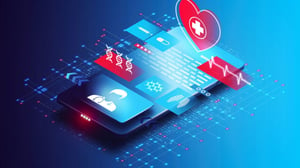
IEC 82304-1: Essential Standard for AI Healthcare Software
Explore IEC 82304-1 for Artificial Intelligence.
Learn how IEC 82304-1 provides the essential framework for AI healthcare software. Explore compliance requirements, challenges, and benefits for your organization.
The healthcare software landscape has transformed dramatically, with Software as a Medical Device (SaMD) now powering critical clinical decisions through artificial intelligence and machine learning algorithms. IEC 82304-1 provides the essential safety framework ensuring these sophisticated health software products meet rigorous international standards for patient protection and regulatory compliance.
Essential Standard for AI-Powered Healthcare Software
Modern healthcare increasingly relies on intelligent software solutions that operate independently of dedicated hardware. From AI-powered diagnostic tools to machine learning algorithms predicting patient outcomes, these health software products require comprehensive safety standards. IEC 82304-1 addresses this critical need by establishing requirements for medical device software that healthcare professionals and patients can trust.
This international standard ensures that health software products maintain safety and security standards equivalent to traditional medical devices while accommodating the unique characteristics of software-based solutions.
Background and Purpose of IEC 82304-1
IEC 82304-1: Health software — Part 1: General requirements for product safety was developed by IEC Technical Committee 62 to address the growing complexity of health software products in the healthcare industry. The standard emerged from the recognition that software as a medical device presents unique challenges not fully addressed by existing medical device standards.
The primary purpose of IEC 82304-1 is to
- Establish safety and security requirements for health software products
- Provide a framework for software lifecycle processes specific to healthcare applications
- Support regulatory compliance for medical device manufacturers
- Bridge gaps between traditional medical device standards and modern software development practices

According to the International Organization for Standardization, IEC 82304-1 "applies to the safety and security of health software products designed to operate on general computing platforms and intended to be placed on the market without dedicated hardware."
Key Definitions and Concepts
Understanding IEC 82304-1 requires familiarity with several critical concepts:
Health Software: Software intended to be used specifically for managing, maintaining, or improving health of individual persons, or the delivery of care.
Software as a Medical Device (SaMD): Software intended to be used for one or more medical purposes without being part of a hardware medical device.
Software Lifecycle Process: The systematic approach to software development encompassing planning, development, verification, validation, and post-production activities.
Product Standard: A standard that specifies requirements for particular products, as opposed to process standards that define how work should be performed.
Importance of IEC 82304-1
Differentiating SaMD from Traditional Medical Devices
While traditional medical devices rely on physical properties for safety assessment, health software products present unique characteristics:
- Performance Metrics: Calculation accuracy, data processing times, and response times replace physical measurements
- Update Capabilities: Software can be modified rapidly, requiring different change management approaches
- Platform Independence: Health software operates across multiple computing platforms and environments
- Data-Driven Functionality: Performance depends heavily on data quality and algorithmic integrity
Enhancing Safety and Performance of Health Software
IEC 82304-1 addresses specific SaMD challenges through:
- Comprehensive Risk Management: Identifying software-specific hazards and implementing appropriate controls
- Validation Requirements: Ensuring health software performs correctly in its intended environment
- Documentation Standards: Providing clear instructions and specifications for safe software use
- Lifecycle Management: Supporting continuous improvement and safe evolution of health software products

Supporting Regulatory Compliance
Medical device manufacturers benefit from IEC 82304-1 compliance through:
- Streamlined regulatory submissions to bodies like the U.S. Food and Drug Administration
- Alignment with international recognized standards
- Clear demonstration of safety and effectiveness
- Support for design control requirements
IEC 82304-1 Framework
Software Life Cycle Requirements
The standard integrates seamlessly with standard IEC 62304, which defines software lifecycle processes for medical device software. This relationship ensures comprehensive coverage from initial concept through post-production management.
Key lifecycle phases include:
- Planning and Requirements: Establishing clear specifications for health software functionality
- Design and Development: Implementing software architecture and algorithms
- Integration and Testing: Verifying software performance and safety
- Release and Deployment: Managing software distribution and installation
- Post-Production Management: Monitoring performance and managing updates
Development to Post-Production Management
IEC 82304-1 emphasizes continuous oversight throughout the software lifecycle:
- Change Control: Managing software modifications while maintaining safety
- Performance Monitoring: Tracking software behavior in real-world environments
- Incident Management: Responding to software-related adverse events
- Legacy Software: Addressing challenges with existing health software products
Seamless Integration with Related Standards
The standard works collaboratively with other recognized standards:
- ISO 13485: Quality management systems for medical devices
- ISO 14971: Risk management for medical devices
- IEC 60601-1: General requirements for basic safety and essential performance of medical electrical equipment
- IEC 80001: Application of risk management for IT-networks incorporating medical devices
Organizations implementing AI regulatory compliance benefit from understanding these interconnections.
Key Components of IEC 82304-1
Software Validation
Software validation under IEC 82304-1 requires demonstrating that health software meets user needs and intended uses:
- Clinical Validation: Confirming software performs correctly in healthcare settings
- Usability Validation: Ensuring healthcare professionals can use software safely and effectively
- Performance Validation: Verifying software meets specified performance criteria
- Interoperability Testing: Confirming software works correctly with other systems
System-Level Requirements
The standard addresses health software within broader healthcare systems:
- Integration Requirements: Ensuring compatibility with existing healthcare infrastructure
- Data Exchange: Supporting secure and accurate information sharing
- User Interface Standards: Providing clear, intuitive interfaces for healthcare professionals
- Telemedicine Platforms: Addressing remote healthcare delivery requirements
Risk Management Practices
Software risk management under IEC 82304-1 follows ISO 14971 principles while addressing software-specific concerns:
- Hazard Identification: Recognizing potential software-related risks
- Risk Analysis: Evaluating probability and severity of identified hazards
- Risk Control: Implementing measures to reduce risks to acceptable levels
- Post-Production Risk Management: Monitoring and responding to emerging risks
Documentation and Testing Protocols
Comprehensive documentation requirements support both regulatory compliance and safe software use:
- Design Specifications: Detailed descriptions of software functionality and performance
- Test Documentation: Evidence of software verification and validation
- User Documentation: Clear instructions for healthcare professionals
- Technical Documentation: Information supporting software maintenance and updates

Integration of Advanced Technologies
Incorporating Artificial Intelligence
The integration of AI technologies in health software presents unique opportunities and challenges:
- Algorithm Transparency: Providing appropriate visibility into AI decision-making processes
- Training Data Management: Ensuring AI models are trained on representative, high-quality data
- Performance Monitoring: Tracking AI system performance over time
- Bias Mitigation: Identifying and addressing potential algorithmic bias
Organizations developing AI-powered health software benefit from ISO/IEC 42001 implementation alongside IEC 82304-1.
Machine Learning in SaMD
Machine learning applications in SaMD development require special consideration:
- Model Validation: Ensuring ML models perform correctly across diverse patient populations
- Continuous Learning: Managing systems that improve through use while maintaining safety
- Data Governance: Protecting patient privacy while enabling effective ML training
- Explainability: Providing healthcare professionals with appropriate insights into ML decisions
Challenges and Considerations
Implementing IEC 82304-1 for advanced technologies involves several key challenges:
- Regulatory Uncertainty: Navigating evolving regulations for AI and ML in healthcare
- Technical Complexity: Managing sophisticated algorithms within regulated environments
- Validation Complexity: Demonstrating safety and effectiveness for adaptive systems
- Resource Requirements: Allocating sufficient expertise and time for comprehensive compliance
Alignments with Related Standards
Relationship with IEC 62304 and ISO 14971
IEC 82304-1 works synergistically with foundational medical device standards:
IEC 62304 provides the process framework for medical device software development, while IEC 82304-1 specifies product requirements. Together, they ensure comprehensive coverage of software development and safety requirements.
ISO 14971 establishes risk management principles that IEC 82304-1 applies specifically to health software contexts, ensuring systematic identification and mitigation of software-related risks.
Complementary Guidelines and Their Relevance
Additional standards enhance IEC 82304-1 implementation:
- ISO 14708: Implantable devices standards for embedded software applications
- EN 82304: European adoption of IEC 82304-1 requirements
- Digital Health Standards: Emerging frameworks for telemedicine and remote monitoring applications
Healthcare organizations can leverage AI management systems to coordinate compliance across multiple standards.
Implementing IEC 82304-1
Steps for Developers and Companies
Successful IEC 82304-1 implementation follows a systematic approach:
- Gap Analysis: Assess current development practices against standard requirements
- Process Enhancement: Integrate IEC 82304-1 requirements into existing workflows
- Documentation Development: Create comprehensive technical and user documentation
- Validation Planning: Design testing protocols specific to health software applications
- Risk Management Integration: Embed software-specific risk assessment throughout development
Best Practices for Adoption
Leading organizations successfully implementing IEC 82304-1 follow several key practices:
- Early Integration: Incorporating standard requirements from project inception
- Cross-Functional Teams: Engaging regulatory, clinical, and technical expertise
- Iterative Validation: Conducting ongoing testing throughout development
- User-Centered Design: Prioritizing healthcare professional and patient needs
- Continuous Improvement: Learning from post-production experience
Common Pitfalls and How to Avoid Them
Organizations should be aware of frequent implementation challenges:
Inadequate Risk Management
Failing to identify software-specific hazards can lead to serious compliance gaps. Ensure comprehensive hazard analysis covering all aspects of software functionality.
Insufficient Documentation
Incomplete technical documentation creates regulatory and operational risks. Invest in thorough documentation from project start.
Limited Clinical Input
Developing health software without adequate healthcare professional involvement often results in products that don't meet real-world needs.
Rushing Validation
Inadequate validation testing can lead to post-production problems and regulatory issues.
The Future of IEC 82304-1
Emerging Trends in Digital Healthcare
Several trends are shaping the evolution of health software standards:
- AI and Machine Learning Integration: Increasing sophistication of intelligent health software systems
- Remote Patient Monitoring: Growing importance of telemedicine platforms and connected health devices
- Real-World Evidence: Enhanced post-production monitoring capabilities
- Personalized Medicine: Software supporting individualized patient care approaches
Continuous Evolution of the Standard
IEC 82304-1 continues evolving to address emerging technologies and healthcare needs:
- AI-Specific Guidance: Enhanced requirements for artificial intelligence applications
- Cybersecurity Integration: Strengthened security requirements for connected health software
- Interoperability Standards: Improved frameworks for health software integration
- Global Harmonization: Increased alignment with international regulatory approaches
Understanding these trends helps organizations implementing ISO/IEC 23053 alongside IEC 82304-1.
Potential Updates and Revisions
Future standard revisions may address:
- Advanced AI and machine learning applications
- Enhanced cybersecurity requirements
- Improved post-production monitoring frameworks
- Streamlined regulatory compliance processes
Frequently Asked Questions
What is the difference between IEC 82304-1, IEC 62304, and ISO 13485?
IEC 82304-1 is a product standard specifying safety requirements for health software products. IEC 62304 is a process standard defining how to develop medical device software. ISO 13485 establishes quality management system requirements for medical device manufacturers. These standards work together: ISO 13485 provides the quality framework, IEC 62304 defines development processes, and IEC 82304-1 specifies product safety requirements.
Are IEC 82304-1, IEC 62304, and ISO 13485 related?
Yes, these standards are complementary and often implemented together. ISO 13485 establishes the quality management foundation, IEC 62304 provides software development processes, and IEC 82304-1 adds specific requirements for health software products. Medical device manufacturers typically need all three for comprehensive compliance.
What is the scope of IEC 82304-1?
IEC 82304-1 applies to health software products designed to operate on general computing platforms without dedicated hardware. It covers standalone software applications used for healthcare purposes but excludes software embedded in medical electrical equipment (covered by IEC 60601 series) and software for implantable devices (covered by ISO 14708 series).
How does SaMD fit into medical device regulations?
Software as a Medical Device (SaMD) is regulated as a medical device under existing regulatory frameworks. While SaMD doesn't have separate regulations, specific guidance documents and standards like IEC 82304-1 address unique software characteristics. SaMD must demonstrate the same safety and effectiveness as traditional medical devices.
What are the key distinctions between SaMD and other types of medical devices?
SaMD differs from traditional medical devices in several ways: it can be updated rapidly, operates across multiple platforms, doesn't have physical properties for safety assessment, and relies heavily on data quality and algorithmic performance. These differences require specialized approaches to validation, risk management, and regulatory compliance.
What is the purpose of IEC 82304-1 in relation to SaMD?
IEC 82304-1 provides essential safety requirements specifically for health software products, including SaMD. It bridges the gap between traditional medical device standards and modern software development practices, ensuring SaMD products meet appropriate safety and security standards while accommodating software-specific characteristics.
How do you develop SaMD following IEC 82304-1?
SaMD development following IEC 82304-1 involves: conducting comprehensive risk management, implementing appropriate software lifecycle processes (typically following IEC 62304), creating thorough documentation including user instructions, performing extensive validation testing, and establishing post-production monitoring systems. The key is integrating these requirements throughout the development process rather than adding them at the end.
Accelerating Your IEC 82304-1 Compliance Journey
IEC 82304-1 provides the essential framework for developing safe, effective health software products in today's AI-driven healthcare environment. By understanding and implementing this standard's requirements, medical device manufacturers can navigate regulatory expectations while delivering innovative solutions that healthcare professionals and patients can trust.
The standard's comprehensive approach to software lifecycle management, risk assessment, and documentation creates a solid foundation for sustainable health software development. Organizations that proactively embrace IEC 82304-1 position themselves for success in the rapidly evolving digital health landscape.
Ready to ensure your health software meets IEC 82304-1 requirements and regulatory expectations? Contact our team today to discuss how we can support your compliance journey and help you develop safer, more effective health software solutions.
Lorem ipsum dolor sit amet
Lorem Ipsum Dolor Sit Amet
Lorem ipsum odor amet, consectetuer adipiscing elit. Elementum condimentum lectus potenti eu duis magna natoque. Vivamus taciti dictumst habitasse egestas tincidunt. In vitae sollicitudin imperdiet dictumst magna.

Lorem Ipsum Dolor Sit Amet
Lorem ipsum odor amet, consectetuer adipiscing elit. Elementum condimentum lectus potenti eu duis magna natoque. Vivamus taciti dictumst habitasse egestas tincidunt. In vitae sollicitudin imperdiet dictumst magna.

Lorem Ipsum Dolor Sit Amet
Lorem ipsum odor amet, consectetuer adipiscing elit. Elementum condimentum lectus potenti eu duis magna natoque. Vivamus taciti dictumst habitasse egestas tincidunt. In vitae sollicitudin imperdiet dictumst magna.

Lorem Ipsum Dolor Sit Amet
ISO/IEC Certification Support
Drive innovation and build trust in your AI systems with ISO/IEC certifications. Nemko Digital supports your certification goals across ISO/IEC frameworks, including ISO 42001, to help you scale AI responsibly and effectively.
Contact Us







